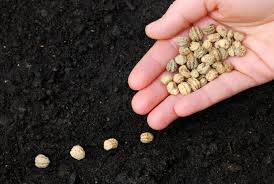Stories from the Farm
Thoughts from our Farm TeamLife is at the Root
To look at the garden now you would think it was dead and lifeless. We are accustomed to thinking of plants as if their being was embodied in their green and growing leaves. But it isn’t so, not really. The life of plants is in the root, not in the flesh.
In perennial plants, like the asparagus in the Cedar Ridge garden, the green flesh that we see (that we eat!) dies away every year. Every leaf will wither, dry up, and fall away in autumn. If you go looking for green life now in our asparagus patch – or anywhere else in the garden – you will be tricked into thinking you are looking at dead ground, because there is nothing but bare soil and brown woody stems. But bare ground means death only if green flesh is the definition of life. The true life in a garden is the hidden kind, the muddy kind, the deep and digging kind: the living root of a perennial plant. The green stuff we see is expendable, seasonal, and fragile.
In April, green will leap out everywhere. Every tree and bush will cover itself in leaf. But the truth will still hold – the real life, the real business of being a plant, remains at the root, hidden, dark and mysterious. This sort of life does not die, it merely goes underground, only to arise again in the warmth and light of an April morning.
Living Water in the Garden
Gardens are made of water. It is literally the stuff of life of all growing things, filling and giving substance to cells and tissues and bodies great and small.
At this time of year the garden’s living water is all on the move – if you stand outside in a quiet place you can hear it: a murmuring voice just below the soft surface of the earth. In another few months we will be standing in our parched garden beds slaking our vegetables’ thirst with water from a hose.
It is then, in scarcity and drought, that water seems sweet and precious. Now, with water in abundance – falling water, rising water, flowing water, muddy water tracked across the kitchen floor on boots and paws – it is tempting to wish away the water of early spring.
We can’t easily plant our garden until the water recedes. If you step into the garden now your shoe will sink and the soil will not spring back. Like a piece of tissue, soil is light and full of air when dry, but heavy and soggy when wet. And, like a sodden tissue, if you compress heavy wet soil and then let it dry it does not spring back into shape. It remains compressed, the empty spaces that normally hold breath and living water squeezed shut.
Soon we will plant early spring crops in the CRCC garden – peas, kale, lettuce, radishes and beets. The soil will still be running with spring’s rising waters, and so we will move carefully and step gently. We will be careful not to compress the soil, careful to leave room for air and water to flow through and nourish our plants. And if you come, too, and plant, you will find the living water, and the living soil, and come away with it on your hands and feet.
Seeds
Seeds went into the ground at the Cedar Ridge Farm in the past few weeks. Lettuce seed, so tiny it feels like chaff in the palm of your hand, beet seed all spiky and rough, and potato seed, which is really no seed at all, but chunks of the vegetable itself, dormant flesh with living eyes. This week there is a green fuzz on the top of the rows, as seeds germinate and push through the crust of earth and head for the sun.
Seeds aren’t alive, really. As they sit waiting for earth they don’t respirate, don’t reproduce, don’t grow. In all likelihood the plant that created the seed is dead and gone, it’s progeny nothing but a handful of dried potential. And yet, in that seed – even the tiny lettuce, or the speck that is a mustard seed – is a dormant embryo, the plant that is to be.
It should be no wonder that we celebrate Easter in the same month that the seeds begin their miraculous rebirth. From a winter when death was so very real, so very near, we arrive at spring, where life is equally insistent, where resurrection must be taken seriously. If Easter were in January, when we are surrounded by the cold and dark, would we find it possible to believe in a risen Christ? How could we, we skeptics and doubters, without the vibrant green evidence of a world that is yearly reborn?
Interested in helping out with the Farm?
Learn about the Farm and how you can participate in our work. Seasonally, there are all kinds of ways you can help keep it going.

